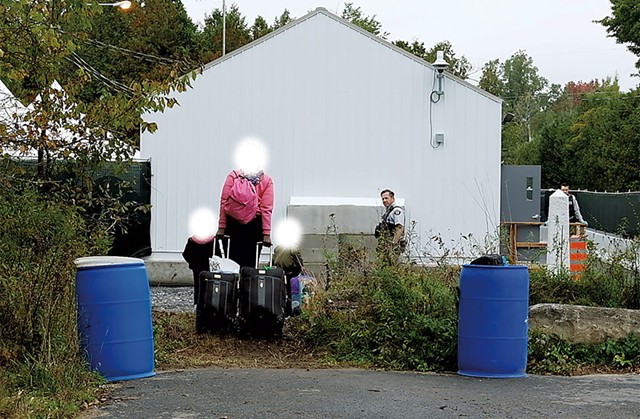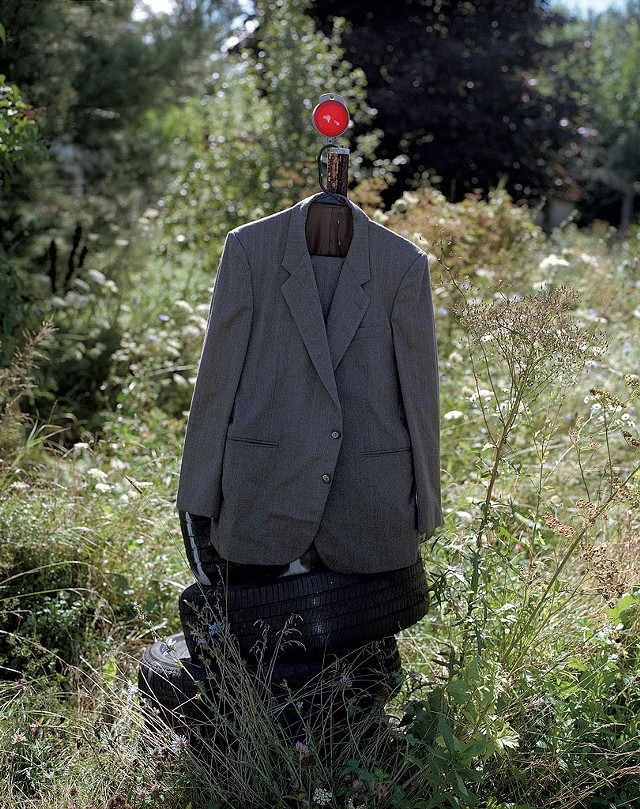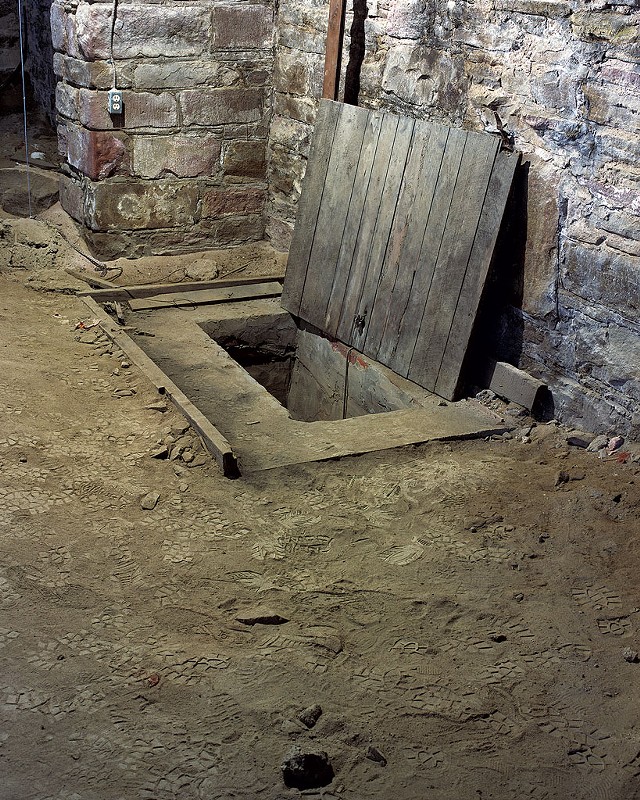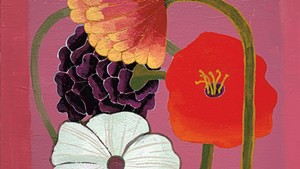
- Courtesy Of Bill Mcdowell
- "Mother in Pink, Roxham Road, October 2018"
"Roxham Road to North Elba" is not a quick trip; the exhibition of seemingly disparate photographs at Burlington's BCA Center requires a little investment of time to parse. But patient viewers will be rewarded with a visual consideration of some deeply fraught issues, both current and historic: racism, migration, humanity, compassion or lack thereof. And it all takes place on the other side of Lake Champlain.
Bill McDowell was born and raised in Plattsburgh, N.Y., just 22 miles south of Québec. He earned a degree at Rochester Institute of Technology in 1986 and worked in commercial photography for several years before returning to academia. McDowell taught initially at RIT, then at Texas A&M University; in 2002, he returned to the North Country for a faculty position at the University of Vermont, which he still holds.
In June 2017, McDowell began to visit Roxham Road, which runs from northern New York into Québec, west of the Champlain-Lacolle border crossing.
It isn't entirely clear how this blip in the border became "the primary route for asylum seekers entering Canada," McDowell observes in a book accompanying his exhibition. Chalk it up to "growing recognition of a 'loophole' in the 2004 Canada-U.S. Safe Third Country Agreement." What also became obvious to asylum seekers was the increasingly hostile and highly politicized American attitude toward immigration. And so, many continue to brave long and perilous journeys en route to Canada.
"From 2017 to 2020 (when the pandemic closed the border), more than 90% of the nearly 60,000 asylum seekers who entered Canada through irregular routes did so at Roxham Road," McDowell writes. When the border reopened in January of this year, nearly 10,000 more came through in the first four months.

- Courtesy Of Bca Center
- "Men's Suit"
How did McDowell choose to portray this human exodus and this half-mile-long area surrounded by farms, woods and scant habitation? Many of his photographs are oblique: shots of snowy roads, nondescript buildings, scrappy trees that fail to disclose their citizenship.
McDowell also shot fascinating objects abandoned by the side of the road. Torn bits of paper turned out to be "an asylum statement written by a Nigerian woman who compellingly documented why she, her child, and husband were no longer safe in Nigeria." A man's dress suit, gray with pinstripes, was hanging from a fence post. "Had the owner decided that, in Canada, he would no longer need to wear it?" McDowell muses. A pile of American coins, mostly pennies, was useless to someone who didn't plan to return.
Some images are more on point — and heartrending. Stills from videos show asylum seekers with suitcases and sometimes children walking toward a bland white building and attendant officers of the Royal Canadian Mounted Police. McDowell obscured their identities completely. "I still-captured a frame and digitally produced a soft, white pod-like shape over each seeker's head," he writes. "Even though their backs were to the camera, the pod nonetheless denies the viewer the ability to fully witness moments of profound vulnerability."
McDowell noted in a recent talk at BCA that the Roxham Road corridor has a "mind-blowing" precedent: the Underground Railroad. "The major east/west thoroughfare running along the border that takes you to Roxham is called North Star Road," he writes. "The road was named years ago for the use of the North Star as a navigational aid by enslaved people seeking freedom."
His dive into that upstate New York history led McDowell to the North Star Underground Railroad Museum in Ausable Chasm; to the town of Keeseville, where escaped slave and abolitionist Frederick Douglass spoke in 1843; and to North Elba, where white abolitionist John Brown lived and his farmhouse still stands.

- Courtesy Of BCA Center
- "Underground Railroad Tunnel, 1st Congregational Church, Malone, N.Y."
"Considering that freedom seekers are once again traveling through the North Country to Canada," McDowell writes, "the sites become monuments to the racial equity work yet to be done."
One photo that speaks volumes is the entrance to an Underground Railroad tunnel: a hole in the dirt floor, wooden door propped open, of the First Congregational Church of Malone, N.Y. An image that needs explanation is the shadow of a so-called lawn jockey in a yard near Keeseville. McDowell digitally removed the offensive statue from the photo, but the long shadow of racism remains.
McDowell pairs photographs from his Underground Railroad and Roxham Road explorations because they are all germane to an unfortunate human story. He eloquently explains this in audio available to gallery visitors via QR codes. And in two photos — selfies by way of his shadow — he inserts himself in the story, interrogating his role as a white, privileged man.
Though he refrains from overt moralizing, McDowell perhaps hopes viewers will also be moved to self-examination, if not activism, in what he calls "a country still divided by the myth of race." At the very least, "Roxham Road to North Elba" illustrates the profound and ongoing consequences of intolerance.










Comments
Comments are closed.
From 2014-2020, Seven Days allowed readers to comment on all stories posted on our website. While we've appreciated the suggestions and insights, right now Seven Days is prioritizing our core mission — producing high-quality, responsible local journalism — over moderating online debates between readers.
To criticize, correct or praise our reporting, please send us a letter to the editor or send us a tip. We’ll check it out and report the results.
Online comments may return when we have better tech tools for managing them. Thanks for reading.